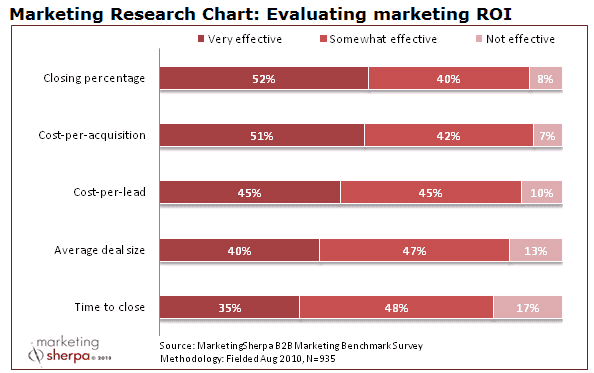Measuring Marketing Performance
 Organizations must continually measure performance to improve and grow. Measuring marketing performance is critical as marketing plays a vital role in an organizations strategy and execution. The trend in measuring marketing performance is shifting from activity-based measurement to results-based measurement. In this article, we’ll discuss the change in performance measurement and suggest ways to effectively measure your marketing performance.
Organizations must continually measure performance to improve and grow. Measuring marketing performance is critical as marketing plays a vital role in an organizations strategy and execution. The trend in measuring marketing performance is shifting from activity-based measurement to results-based measurement. In this article, we’ll discuss the change in performance measurement and suggest ways to effectively measure your marketing performance.
From activities to results
Historically, marketing performance has been measured on activities. For example, consider a trade show event. Marketers were typically measured on number of trade shows attended in a given period along with number of leads collected from the show. Similarly, consider email marketing. Marketers were graded on number of email opens or click throughs. It’s true, what gets measured gets done. When measuring marketing performance focus on what really matters, results. Instead of counting email opens and number of cards collected from trade shows, measure marketing based on revenue. What percentage of contacts results in an opportunity or a closed deal? If marketing and sales are both measured on revenue performance companies will benefit from closer sales and marketing alignment.
How other companies are measuring marketing performance
A recent study conducted by MarketingSherpa on more than 900 marketers asked which key performance metrics helped them evaluate marketing ROI. Interestingly, the top 5 measurements each pertain to a deal (end of the sales cycle) and cost of the contact (beginning of the sales cycle), which both greatly influence the revenue cycle.

How to impact important marketing metrics
With a renewed focus on revenue results and new metrics in mind, marketers can execute their revised strategy. To accomplish this, many marketers use technology, such as marketing automation, to achieve their goals. Lead Liaison provides revenue generation software, which includes marketing automation, for this reason. Here’s how Lead Liaison’s technology supports each metric:
• Closing percentage. Lead nurturing uses customer/prospect profiles to send scheduled, intelligent communications that build relationships and close more deals. Lead scoring automatically qualifies leads to send only the best leads to sales. Sales remains focused on sales-ready leads and optimizes their time around revenue, resulting in more wins and higher close percentage.
• Cost-per-acquisition. Lead tracking and lead generation technology creates leads from various inbound marketing activities. Leads opt-in to Lead Liaison via web form submission, response to an email campaign, or manual opt-in to become a lead in the system. Generating more leads with the same amount of inbound marketing results in higher marketing ROI and lower cost-per-acquisition.
• Cost-per-lead. Marketing segmentation allows marketers to segment a database based on a number of demographics (revenue, location, etc.) and activities (product interest, recent website visits, etc.). By re-marketing to an existing database, a company’s most valuable asset, marketers get “stale” leads on nurturing programs. As a result, marketers do not have to acquire as many leads via list brokers or trade shows. By using what a marketer already has they reduce cost-per-lead.
• Average deal size. Companies end up paying more for quality solutions from trusted advisers whom they’ve built relationships with. Lead nurturing builds the necessary relationships with customers and prospects over time while establishing the vendor as a trusted authority.
• Time to close. Lead nurturing ensures companies are in constant communication with leads using relevant messaging. Leads will always have the company and/or solution at the top of their mind. Additionally, leads won’t “stray”. In totality, these factors result in shorter sales cycles and less time to close.
We welcome your feedback, comments and suggestions. How is your company measuring marketing performance?
To be alerted of future posts, please click on the RSS button.


